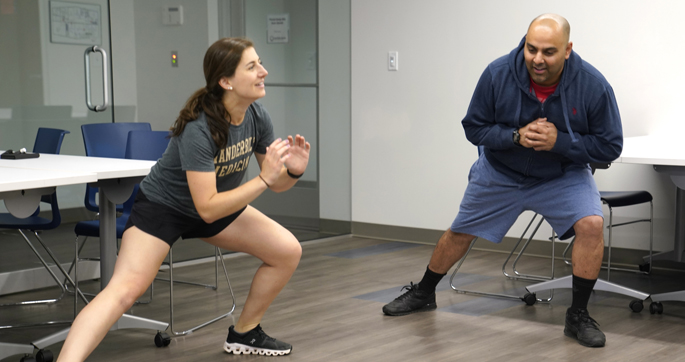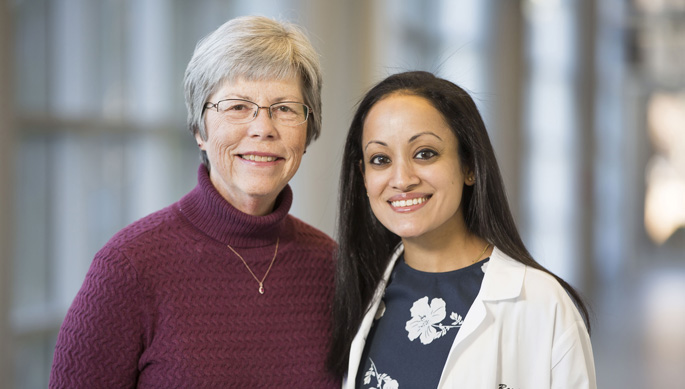
by Jill Clendening
Seventy-five percent of participants in a diabetes prevention program (DPP) run by medical students lost at least 5% of their body weight, and many participants also reported less pain and an overall improved quality of life.
Vanderbilt University School of Medicine (VUSM) students recently published an evaluation of their inaugural DPP in the Journal of Student-Run Clinics. Because of the positive outcomes, plans are to continue the program and expand it beyond the walls of the Shade Tree Clinic, the VUSM student-run health clinic in Nashville that serves uninsured and underinsured individuals.
“Dr. Michael Fowler, who until his recent passing was a co-medical director of Shade Tree Clinic, thought it would be a great idea if the medical students could stand up a DPP and study its effectiveness at the clinic,” said Kevin Niswender, MD, PhD, associate professor of Medicine, who mentored the group. “The study received VICTR [Vanderbilt Institute of Clinical and Translational Research] funding, and the first cohort was enrolled just before COVID-19 hit.”
The VUSM students modeled their program after the Centers for Disease Control and Prevention’s National Diabetes Prevention Program, a public-private initiative established in 2010 to address the burden of prediabetes and Type 2 diabetes in the United States. A key DPP component is the promotion of healthy eating and physical activity. DPP-based studies have shown that individuals at high risk for Type 2 diabetes can cut their risk of developing the disease by 58% with these lifestyle changes. For those over 60, risk is cut by 71%.

“Low-resource and minority communities are at the highest risk for developing Type 2 diabetes, but their participation in something like a DPP is often not possible because of lack of access to such programs, as well as barriers such as cost, lack of transportation and child care,” said fourth-year VUSM student Meredith Huszagh. “There was a lot of brainstorming about how we could take the national DPP curriculum and adapt it to our specific community at Shade Tree.”
For the project, Jeremy “Britt” Hatcher, MD, served as executive director, Huszagh was co-director of patient engagement, and Xuanyi “Lexi” Li, MD, was co-director of logistics.
Four medical students attended national training to learn how to be DPP health coaches. In this role, students led weekly educational and exercise sessions. Other students served as health mentors; they called participants weekly to check-in with them. Dietetic interns provided information on healthy food choices and led teaching kitchens to provide hands-on instruction.
The program initially enrolled Spanish-speaking patients of Shade Tree, with the added motivation of also allowing eligible family and friends of participants to attend. Free child care was offered during in-person sessions, and options were provided if transportation was an issue.
Because it was grant-funded and run by medical students, the program was offered at no cost to participants. Typically, the cost to participate in a DPP averages $500 per person.
The medical student-run DPP had just concluded the initial, 16-week core curriculum with 17 participants when the COVID-19 pandemic halted in-person meetings. The program was paused briefly while content was transformed to a virtual, Zoom format.
“Watching these medical students take this on, organize everything and deliver this was just absolutely incredible,” said Niswender. “They did an utterly amazing job under what were the most miserable and difficult conditions once COVID hit.”
Scales for self-reporting weight, yoga mats and exercise bands were delivered to participants. Technological issues were tackled to ensure everyone could reconnect over Zoom.
“We definitely had to get creative,” Huszagh said. “One of the most exciting successes of the program is that we were able to take about a two-and-a-half-week pause, transition everything to virtual and then resume sessions.”
With additional cohorts of the DPP, Meharry Medical College medical students who operate the Salt Wagon Clinic, a free health clinic at Nashville General Hospital, are participating and enrolling eligible individuals. A DPP health coach curriculum has been developed locally to eliminate the cost of national training.
Plans are for medical students to continue offering the program to eligible uninsured or underinsured community residents, extending the scope beyond clinics. And the group hopes publishing their results generates interest at other medical student-run clinics across the country.
Huszagh, who has interests in both endocrinology and health care disparities, will soon begin a residency in obstetrics, gynecology and women’s health at the University of Minnesota. Because of the outcomes she witnessed with the DPP, she hopes to pursue a similar patient health education program for gestational diabetes prevention in the future. Which illustrates yet another DPP success, Niswender said.
“When you run a DPP in a student-run health clinic setting, you recruit new health coaches every year to keep the program going,” he said. “Once the program has been running four or five years, you’ve sent 30 people out into the world with DPP training. They can then train others. The hope is this will snowball throughout medical education and hopefully throughout the practice of medicine. These students have seen the value of this, and they can take this into their own practices wherever they land.”














